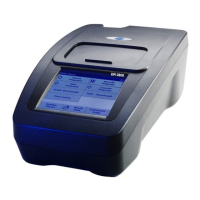48
Advanced Operations
6.1.1 Programming a New User Method
All input steps and their significance and options are explained in
the following sections.
1. From Program Options, select New.
Program Number:
Specific test number, with which the program can subsequently be
called up from the selection list in the User Programs menu or the
Favorites menu.
2. Use the alphanumeric keypad to enter a program number
between 950 and 999. The lowest available number appears
automatically.
3. Press OK.
Note: If the program number is already assigned to another user
program, a message appears, asking whether the existing program
should be replaced. Press
OK to overwrite the existing program.
Program Name:
4. Use the alphanumeric keypad to enter a program name. The
name can be a maximum of 28 characters long. Repeat a key
press to select another of the three letter options. Use the
underscore key for spaces.
5. Press
BACK to go to the previous program point or press NEXT
to continue with the input of the program data.
Program Type:
6. Select the required option (Table 7) and press
NEXT.
7. If the Single Wavelength (section 6.1.1.1 on page 49) or
Multi-wavelength (section 6.1.1.2 on page 50) is selected,
define the unit, wavelength, absorbance formula,
wavelength λ
x,
concentration factor K
x
, concentration
resolution, chemical form and calibration equation.
See Appendix B on page 91 for information on Free
Programming parameters.
Table 7 Program Descriptions
Program Type Description
Single Wavelength Measurements at a defined wavelength.
Multi Wavelength
In the Multi Wavelength mode, absorbance values can be measured at up to four wavelengths
and the results can be mathematically processed to obtain sums, differences and relationships.
Free Programming
This is an advanced form of programming for original user-developed methods. In Free
Programming, the user defines the measurement process, variables, and calculations involved in
obtaining a reading. See Appendix B on page 91 for information on Free Programming
parameters.

